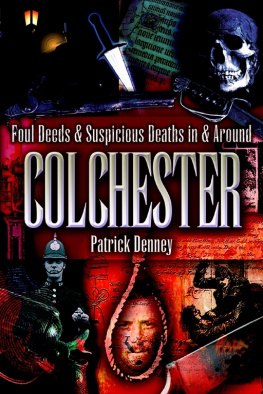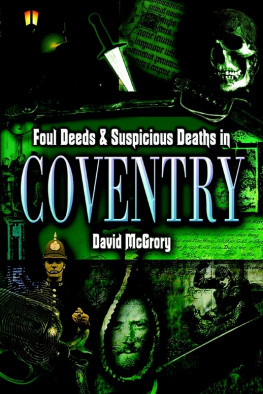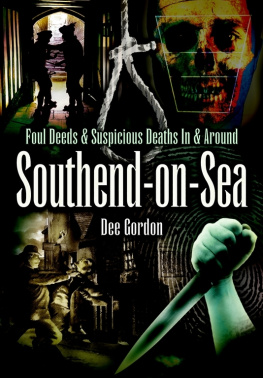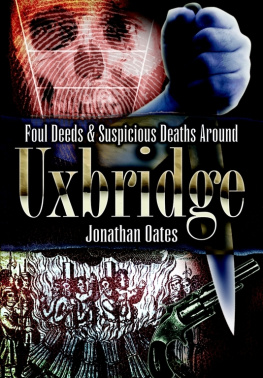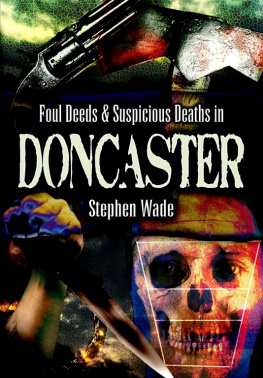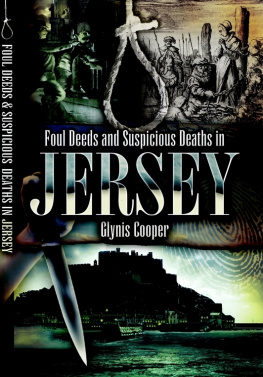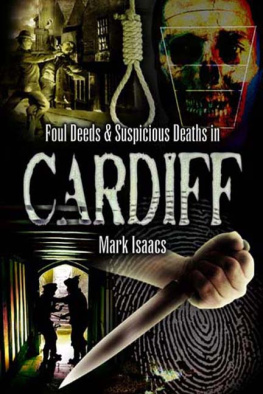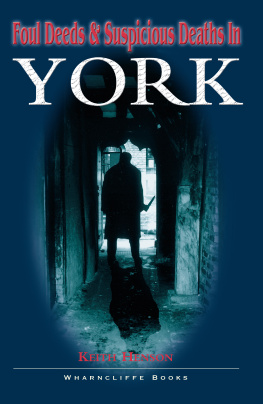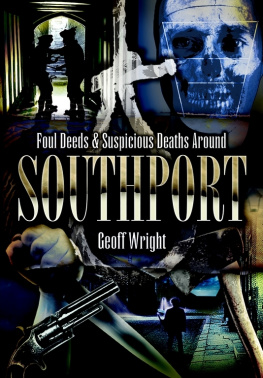
TRUE CRIME FROM WHARNCLIFFE
Foul Deeds and Suspicious Deaths Series
Staffordshire and The Potteries
More Foul Deeds Wakefield
Colchester
Mansfield
Manchester
Leicester
Guilford
Stratford and South Warwickshire
Derby
Brighton
Northampton
Folkestone and Dover
Pontefract and Castleford
Oxfordshire
Tees
Black Country
Bedford
Durham
Bristol
Bradford
Carlisle
Cambridge
Newcastle
Halifax
Southend-on-Sea
Scunthorpe
Barnsley
Barking, Dagenham & Chadwell Heath
Birmingham
Bath
Blackburn and Hyndburn
More Foul Deeds Birmingham
Chesterfield
Bolton
Coventry
More Foul Deeds Chesterfield
Ealing
Croydon
Guernsey
Grimsby
Huddersfield
Hampstead, Holborn and St Pancras
Leeds
Hull
Liverpool
Lewisham and Deptford
Newport
Londons West End
Nottingham
Norfolk
Rotherham
Portsmouth
Londons East End
Warwickshire
Wigan
York
OTHER TRUE CRIME BOOKS FROM WHARNCLIFFE
Norfolk Mayhem and Murder
Executions & Hangings in Newcastle
The A-Z of London Murders
and Morpeth
Unsolved Murders in Victorian and
Norwich Murders
Edwardian London
Unsolved Norfolk Murders
Unsolved Yorkshire Murders
Yorkshires Murderous Women
A-Z Yorkshire Murder
Black Barnsley
Brighton Crime and Vice 1800-2000
Durham Executions
Essex Murders
Strangeways Hanged
Please contact us via any of the methods below for more information or a catalogue.
WHARNCLIFFE BOOKS
47 Church Street Barnsley South Yorkshire S70 2AS
Tel: 01226 734555 734222 Fax: 01226 734438
E-mail: enquiries@pen-and-sword.co.uk
Website: www.wharncliffebooks.co.uk


First Published in Great Britain in 2007 by
Wharncliffe Books
an imprint of
Pen and Sword Books Ltd
47 Church Street
Barnsley
South Yorkshire
S70 2AS
Copyright Kirsten Elliott 2007
ISBN: 978-184563-029-4
eISBN: 978-178303-774-2
The right of Kirsten Elliott to be identified as the author of this work has been asserted by her in accordance with the Copyright, Designs and Patents Act 1988.
A CIP catalogue record for this book is available from the British Library.
All rights reserved. No part of this publication may be reproduced, stored in a retrieval system, or transmitted, in any form or by any means, electronic, mechanical, photocopying, recording or otherwise, without the prior permission in writing of the publishers.
Typeset in 10/12pt Plantin by Concept, Huddersfield.
Printed and bound in England by CPI UK.
Pen and Sword Books Ltd incorporates the Imprints of
Pen & Sword Aviation, Pen & Sword Maritime,
Pen & Sword Military, Wharncliffe Books,
Pen & Sword Select, Pen and Sword Military Classics
and Leo Cooper.
For a complete list of Pen & Sword titles please contact
PEN & SWORD BOOKS LIMITED
47 Church Street
Barnsley
South Yorkshire
S70 2BR
England
E-mail: enquiries@pen-and-sword.co.uk
Website: www.pen-and-sword.co.uk
Introduction
V isitors come to Bath mainly for its history and architecture. With the Roman Baths, the Georgian terraces, and a lively restaurant and pub culture, it offers them a welcome. It is marketed in many ways Bath the Georgian City, the Floral City, even the City of Love. What the guidebooks do not say, however, is that it could equally be Bath the City of Crime or at least Bath the City of Mysteries. In this book, we look at some of these dark or puzzling events. Many deal with death by murder, manslaughter, or by the victims own hand. Some turn out to be less exciting than first thought. For fiction writers, the city has also proved irresistible as a scenario for dark deeds, and for aficionados of the detective story, we look at some of the best crime novels set here. To whet your appetite, heres the story of the crime that got away.
Among the list of famous perhaps that should be notorious murders, the story of the Brides in the Bath ranks highly. What is not widely known is that the murderer had, appropriately perhaps, a Bath connection. The final Bride in the Bath, Margaret Lofty, was literally that, having made the fatal error of marrying her killer, George Smith, in the city. Smith, who operated under a number of aliases, was using the name John Lloyd when he came to stay in Bath in December 1914. He told the landlady that he needed a room for a young lady the unfortunate Margaret Elizabeth Lofty, the daughter of a wealthy Bristol clergyman. She arrived on 15 December and they were married at Bath Registry Office, then situated at No. 3 North Parade. Had Smith decided to stay in the city, Bath might forever be connected with his activities, especially in view of the name which the popular press gave to the series of murders. Fortunately for the citys image, they caught a train to London and took lodgings in Holloway.
On 18 December, Margaret made a will in her husbands favour. By the evening she was dead, drowned in the bath. Although no suspicions were aroused at the time, the inquest was reported in the News of the World, together with a picture of John Lloyd. An alert Blackpool lodging-house keeper spotted that Lloyd looked a lot like George Smith, whose wife Alice had also drowned in the bath, at his lodging-house. He wrote to the police and the truth about Smith, also known as Henry Williams, came to light. Bessy Williams had been his first victim, followed by Alice, and then Margaret. All had drowned in their baths. He was also a serial bigamist, two previous wives having escaped his bagnatorial attentions. He was hanged at Maidstone Gaol in August 1915.
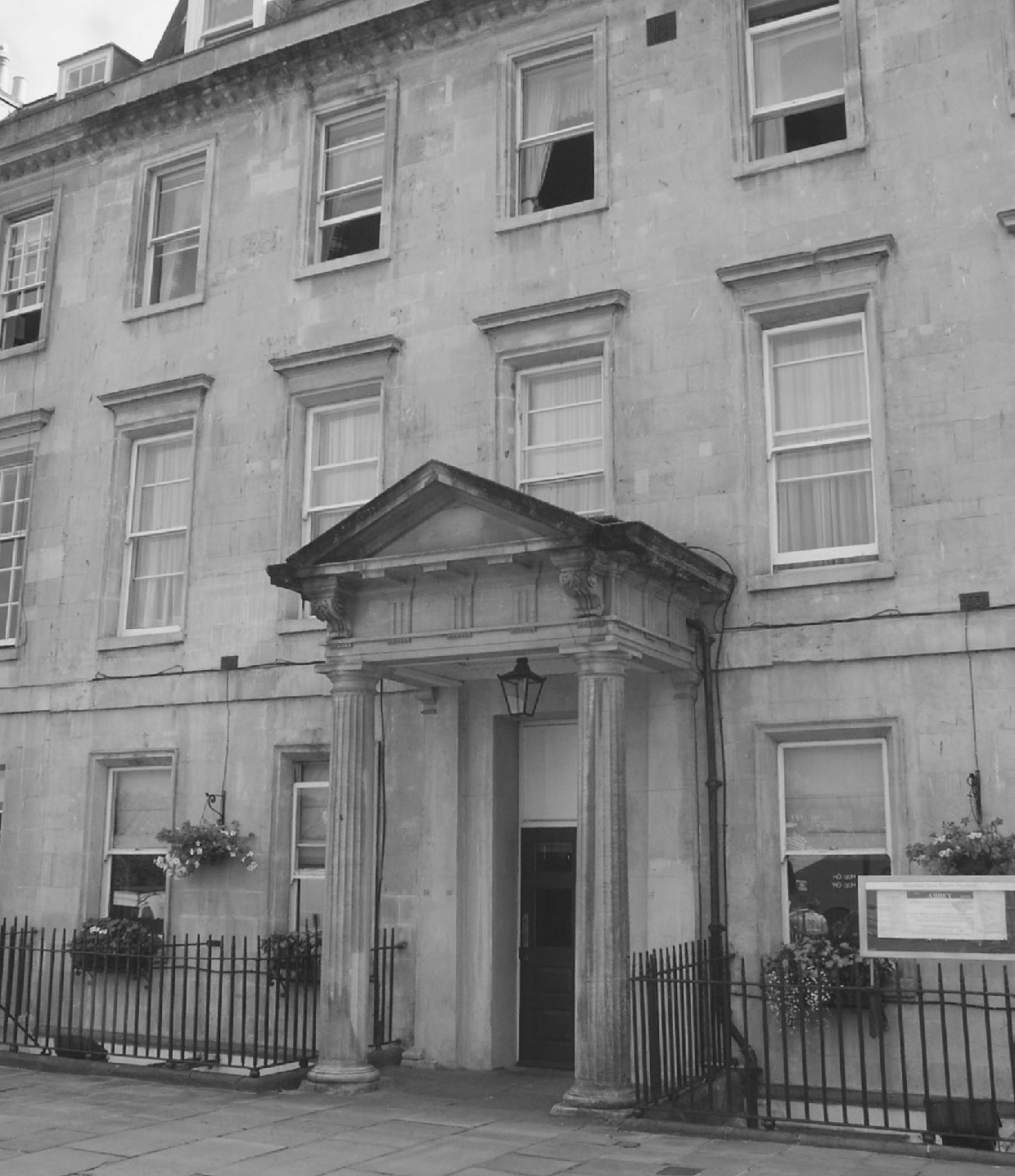
No. 3 North Parade in 1914 this was Bath Registry Office, and here the unfortunate Margaret Lofty married George Smith. The Author
During the investigations, another Bath connection came to light. At an earlier stage in his career, Smith had run a shop in Bath, during which time he had written several letters to the Bath Chronicle. They were on subjects such as the lack of probity in civic life, the decline of moral values among the young, hooliganism in the city, and the baleful effects of popular fiction. He would doubtless disapprove strongly of a book such as this, dealing as it does with morally dubious characters, mob violence, and an entire chapter on popular fiction. With a seal of disapproval like that, I hope you will feel impelled to read on.
Acknowledgements
A s ever with my books based on research, I would like to thank the staff of Bath Central Library for their patience and assistance, as well as the ever-helpful Colin Johnston and his staff at Bath Record Office.
Thanks also go to Derek Stimpson and the Gunmakers Company for assistance relating to the death of John Hanning Speke. I am indebted to them for information relating to shotguns and shooting practices of the mid-nineteenth century. Mr Stimpson provided the likely reconstruction of the cause of the shooting.
Next page

